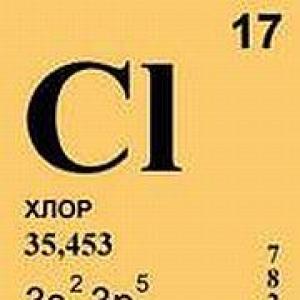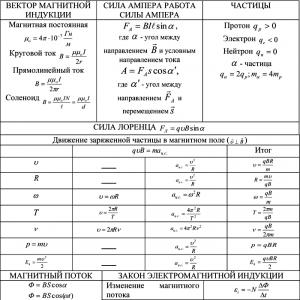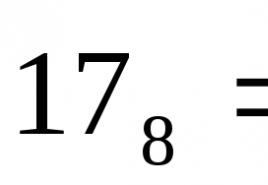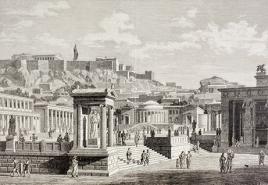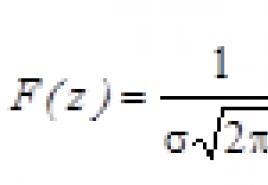How are the isotopes of chlorine different? Nuclides
Introduction……………………………………………………………………………………………………………3
1. Symbol of an element, its position in the periodic table of elements D.I. Mendeleev. Atomic mass………………………………………………………………………………….4
2. The structure of the nucleus of the chlorine atom. Possible isotopes. Examples………………………….5
3. Electronic formula of the atom: distribution of electrons by levels, sublevels, Hund cells. Excited state of the chlorine atom…………………………………………………………….6
4. Valence of the aluminum atom in stationary and excited states. Possible oxidation states of the chlorine atom. Redox properties. Examples of schemes for the movement of electrons…………………………………………………………………………….8
5. Equivalents of chlorine and its compounds. Examples of calculations……………………………..11
6. Chemical properties of chlorine and its compounds. Examples of reactions…………………12
7. Types of concentrations………………………………………………………………………………….15
8. Electrolytic dissociation. Scheme of the hydroxide dissociation process. Dissociation constant………………………………………………………………………………………17
9. Calculation of pH, pOH of a 0.01 m solution of hydroxide or salt of an element………………………21
10. Hydrolysis………………………………………………………………………………..23
11. Qualitative analysis of chlorine………………………………………………………………24
12. Methods for the quantitative determination of the chlorine atom or its compounds……………27
12.1. Gravimetric method for analyzing the chlorine atom………………………………………………………...27
13. Conclusion……………………………………………………………………………….29
References………………………………………………………………………………32
Introduction
The compound with hydrogen - gaseous hydrogen chloride - was first obtained by Joseph Priestley in 1772. Chlorine was obtained in 1774 by the Swedish chemist Karl Wilhelm Scheele, who described its isolation when reacting with pyrolusite and hydrochloric acid in his treatise on pyrolusite:
Scheele noted the smell of chlorine, similar to the smell of aqua regia, its ability to interact with gold and cinnamon, as well as its bleaching properties. However, Scheele, in accordance with the theory of phlogiston that dominated chemistry of that time, suggested that chlorine is a dephlogisticated muriatic (hydrochloric) acid. Bertholley and Lavoisiev, within the framework of the oxygen theory of acids, proved that the new substance should be the oxide of a hypothetical element Muria. However, attempts to isolate it remained unsuccessful until the work of Davy, who managed to decompose table salt into sodium chlorine by electrolysis, proving the elemental nature of the latter.
1. The symbol of the element, its position in the periodic system of elements d.I. Mendeleev. Atomic mass
X  lor (from the Greek χλωρός - “green”) is an element of the 17th group of the periodic table of chemical elements (according to the outdated classification - an element of the main subgroup of group VII), the third period, with atomic number 17. Denoted by the symbol Cl (lat. Chlorum). Chemically active non-metal. It is part of the group of halogens (originally the name “halogen” was used by the German chemist Schweiger for chlorine - literally “halogen” is translated as salt oxide - but it did not catch on and subsequently became common to the 17th (VIIA) group of elements, which includes chlorine).
lor (from the Greek χλωρός - “green”) is an element of the 17th group of the periodic table of chemical elements (according to the outdated classification - an element of the main subgroup of group VII), the third period, with atomic number 17. Denoted by the symbol Cl (lat. Chlorum). Chemically active non-metal. It is part of the group of halogens (originally the name “halogen” was used by the German chemist Schweiger for chlorine - literally “halogen” is translated as salt oxide - but it did not catch on and subsequently became common to the 17th (VIIA) group of elements, which includes chlorine).
The simple substance chlorine (CAS number: 7782-50-5) under normal conditions is a poisonous gas of yellowish-green color, heavier than air, with a pungent odor. The chlorine molecule is diatomic (formula Cl2).
Atomic mass
(molar mass)
[comm 1] a. e.m. (g/mol)
2. The structure of the nucleus of the chlorine atom. Possible isotopes. Examples
There are 2 stable isotopes of chlorine found in nature: with a mass number of 35 and 37. The proportions of their content are respectively 75.78% and 24.22%.
|
Isotope |
Relative mass, a.m.u. |
Half life |
Type of decay |
Nuclear spin |
|
Stable | ||||
|
β-decay of 36 Ar | ||||
|
Stable | ||||
|
37.2 minutes |
β decay in 38 Ar | |||
|
55.6 minutes |
β decay to 39 Ar | |||
|
1.38 minutes |
β decay in 40 Ar |
3. Electronic formula of the atom: distribution of electrons across levels, sublevels, Hund cells. Excited state of the chlorine atom

Chlorine in the periodic table of chemical elements is in period 3, group VII, the main subgroup (halogen subgroup).
Charge of the nucleus of an atom Z = + = + 17
Number of protons N(p+) = 17
Number of electrons N(e-) = 17
In an excited state:
1) 3s2 3p5 3d0 + hn --> 3s2 3p4 3d1
3 unpaired electrons (2 electrons on the 3p sublevel and 1 electron on the 3d sublevel), therefore the valence is 3
Compound example: HClO2, Cl2O3
2) 3s2 3p4 3d1 + hn --> 3s2 3p3 3d2
5 unpaired electrons (3 electrons on the 3p sublevel and 2 electrons on the 3d sublevel), therefore the valence is 5
Compound example: HClO3, Cl2O5
3) 3s2 3p3 3d2 + hn --> 3s1 3p3 3d3
7 unpaired electrons (1 electron in the 3s sublevel, 3 electrons in the 3p sublevel and 3 electrons in the 3d sublevel), therefore the valency is 5
4. Valence of the aluminum atom in stationary and excited states. Possible oxidation states of the chlorine atom. Redox properties. Examples of electron movement schemes
Valence electrons: 3s2 3p5
In the unexcited state, the chlorine atom at the 3rd energy level has one unpaired electron, therefore, an unexcited chlorine atom can exhibit valence 1. Valence 1 appears in the following compounds:
Chlorine gas Cl2 (or Cl-Cl)
Sodium chloride NaCl (or Na+ Cl-)
Hydrogen chloride HCl (or H-Cl)
Hypochlorous acid HOCl (or H-O-Cl)
Redox properties.
HCl - oxidation state of chlorine -1
HClO3 - oxidation state of chlorine +5
HClO4 - oxidation state of chlorine +7
An intermediate oxidation state indicates that this element can exhibit both reducing and oxidizing properties, this is HClO3
Oxidizing properties are exhibited by elements that have a maximum oxidation state (it is equal to the number of the group in which the element is located). This means that HClO4 is an oxidizing agent.
Reducing properties are possessed by an element with a lower degree of oxidation, i.e. HCl is a reducing agent.
Chlorine is a strong oxidizing agent. Various chlorine compounds can be used as oxidizing agents. These are chlorine C12), hypochlorous acid NSO, salts of hypochlorous acid - sodium hypochlorite NaCIO or calcium hypochlorite Ca (CIO) 2 and chlorine oxide CIO2.
Chlorination is used to remove phenols, cresols, cyanides, hydrogen sulfide from wastewater. To combat biological fouling of structures, it is used as a biocide. Chlorine is also used to disinfect water.
Chlorine is supplied to production in liquid form with a content of at least 99.5%. Chlorine is a highly toxic gas, it has the ability to accumulate and concentrate in small depressions. He is quite difficult to work with. When released into water, chlorine is hydrolyzed to form hydrochloric acid. With some organic substances that are present in solution, C12 can enter into chlorination reactions. As a result, secondary organochlorine products are formed, which are highly toxic. Therefore, they strive to limit the use of chlorine.
Hypochlorous acid HCJ has the same oxidizing ability as chlorine. However, its oxidizing properties appear only in an acidic environment. In addition, hypochlorous acid is an unstable product - it decomposes over time and in light.
Salts of hypochlorous acid are widely used. Calcium hypochlorite Ca(Cl)2 is available in three grades with active chlorine concentrations from 32 to 35%. In practice, the dibasic salt Ca(Cl)2- 2Ca(OH)g 2H20 is also used.
The most stable sodium hypochlorite salt is NaOCl * 5H20, which is obtained by chemical interaction of gaseous chlorine with an alkali solution or by electrolysis of common salt in a bath without a diaphragm.
Chlorine oxide CO2 is a greenish-yellow gas, highly soluble in water, a strong oxidizing agent. It is obtained by reacting chlorite NaC102 with chlorine, hydrochloric acid or ozone. When chlorine oxide interacts with water, chlorination reactions do not occur, which excludes the formation of organochlorine substances. Recently, extensive research has been carried out to clarify the conditions for replacing chlorine with chlorine oxide as an oxidizing agent. A number of Russian factories have introduced advanced technologies using CO2.
DEFINITION
Chlorine- the seventeenth element of the Periodic Table. Designation - Cl from the Latin "chlorum". Located in the third period, VIIA group. Refers to non-metals. The nuclear charge is 17.
The most important natural chlorine compound is sodium chloride (table salt) NaCl. The main mass of sodium chloride is found in the water of the seas and oceans. The waters of many lakes also contain significant amounts of NaCl. It is also found in solid form, forming in places in the earth’s crust thick layers of so-called rock salt. Other chlorine compounds are also common in nature, for example potassium chloride in the form of the minerals carnallite KCl × MgCl 2 × 6H 2 O and sylvite KCl.
Under normal conditions, chlorine is a yellow-green gas (Fig. 1), which is highly soluble in water. When cooled, crystalline hydrates are released from aqueous solutions, which are clarates of the approximate composition Cl 2 × 6H 2 O and Cl 2 × 8H 2 O.
Rice. 1. Chlorine in liquid state. Appearance.
Atomic and molecular mass of chlorine
The relative atomic mass of an element is the ratio of the mass of an atom of a given element to 1/12 of the mass of a carbon atom. Relative atomic mass is dimensionless and is denoted by A r (the index “r” is the initial letter of the English word relative, which means “relative”). The relative atomic mass of atomic chlorine is 35.457 amu.
The masses of molecules, as well as the masses of atoms, are expressed in atomic mass units. The molecular mass of a substance is the mass of a molecule, expressed in atomic mass units. The relative molecular mass of a substance is the ratio of the mass of a molecule of a given substance to 1/12 of the mass of a carbon atom, the mass of which is 12 amu. It is known that the chlorine molecule is diatomic - Cl 2. The relative molecular weight of a chlorine molecule will be equal to:
M r (Cl 2) = 35.457 × 2 ≈ 71.
Isotopes of chlorine
It is known that in nature chlorine can be in the form of two stable isotopes 35 Cl (75.78%) and 37 Cl (24.22%). Their mass numbers are 35 and 37, respectively. The nucleus of the atom of the chlorine isotope 35 Cl contains seventeen protons and eighteen neutrons, and the isotope 37 Cl contains the same number of protons and twenty neutrons.
There are artificial isotopes of chlorine with mass numbers from 35 to 43, among which the most stable is 36 Cl with a half-life of 301 thousand years.
Chlorine ions
The outer energy level of the chlorine atom has seven electrons, which are valence electrons:
1s 2 2s 2 2p 6 3s 2 3p 5 .
As a result of chemical interaction, chlorine can lose its valence electrons, i.e. be their donor, and turn into positively charged ions or accept electrons from another atom, i.e. be their acceptor and turn into negatively charged ions:
Cl 0 -7e → Cl 7+ ;
Cl 0 -5e → Cl 5+ ;
Cl 0 -4e → Cl 4+ ;
Cl 0 -3e → Cl 3+ ;
Cl 0 -2e → Cl 2+ ;
Cl 0 -1e → Cl 1+ ;
Cl 0 +1e → Cl 1- .
Chlorine molecule and atom
The chlorine molecule consists of two atoms - Cl 2. Here are some properties characterizing the chlorine atom and molecule:
Examples of problem solving
EXAMPLE 1
| Exercise | What volume of chlorine must be taken to react with 10 liters of hydrogen? Gases are under the same conditions. |
| Solution | Let us write the equation for the reaction between chlorine and hydrogen: Cl 2 + H 2 = 2HCl. Let's calculate the amount of hydrogen substance that reacted: n (H 2) = V (H 2) / V m; n (H 2) = 10 / 22.4 = 0.45 mol. According to the equation, n (H 2) = n (Cl 2) = 0.45 mol. Then, the volume of chlorine that reacted with hydrogen is equal to: |
Most elements found in nature are composed of several types of atoms, differing in relative atomic mass.
Example. Chlorine occurs in nature as a mixture of two types of atoms, one containing 18 and the other 20 neutrons in the nucleus.
Each type of atom, regardless of belonging to a specific element, is uniquely described by the number of nucleons (the sum of protons and neutrons). Therefore, the number of types of atoms exceeds the number of elements.
Each type of atom (type of nucleus) is called a nuclide.
A nuclide is a type of atoms and nuclei that corresponds to certain numbers of protons and neutrons.
Nuclides belonging to the same element and uniquely identifiable
number of protons, but differing in the number of neutrons, are called isotopic nuclides, or simply isotopes.
Isotopes of an element are nuclides that have an equal nuclear charge (number of protons).
The isotopes of an element differ only in the number of neutrons and therefore in the total number of nucleons.
For example: The nuclei of two natural isotopes of chlorine contain 17 protons each, but 18 and 20 neutrons, i.e. 35 and 37 nucleons, respectively.
Due to the fact that it is the number of protons in the nucleus that determines the number of electrons in the shell of an atom and the chemical properties of the element, it follows that the atoms of all isotopes of the same element have the same electronic structure, and the isotopes themselves have similar chemical properties, which is why they are not can be separated by chemical methods.
There are elements in nature that have only one isotope. Such elements are called isotopically pure. In the modern Periodic system, there are 21 isotopically pure elements (they are listed below in ascending order of serial number): Be, F, Na, Al, P, Sc, Mn, Co, As, Y, Nb, Rh, I, Cs, Pr, Tb, Ho, Tm, Au, Bi, Th.
The remaining natural elements are a mixture of two or more isotopes whose atoms differ in the number of nucleons. Such elements are called isotropically mixed, they are in the majority in the Periodic system. The values of the relative atomic masses of such elements correspond to the natural mixture of isotopes and are averaged over the abundance of isotopes; therefore, the values of A r of many elements deviate strongly from integer values. Even carbon, which is taken as the reference point for the relative atomic masses of other elements, is an isotope-mixed element (two isotopes with A, = 12 and A, = 13), and the measure for determining the relative atomic mass is one of the natural isotopes of carbon, namely carbon –12. The element tin has the largest number of isotopes (ten).
For nuclides, the exact values of relative atomic masses are always close to integer values, so the masses of nuclides can be compared by these values of A r, called mass numbers.
The mass number of a nuclide is equal to the number of nucleons it contains (the sum of protons and neutrons).
To designate a specific nuclide, special symbols are used. To the left of the symbol of a chemical element, the mass number is indicated by the superscript, and the charge of the nucleus is indicated by the lower index. For example: 6 12 C, 17 35 Cl, etc.
And, therefore, different atomic mass.
Isotopes are denoted by the same symbols as a chemical element, adding a mass number to the top left of the symbol, for example, isotopes of chlorine denote: 35 Cl And 37 Cl, or the mass number follows the name or symbol of the element, such as uranium-233 or Pu-239.
Isotopes of a given chemical element have the same nuclear charge, that is, one serial number, and occupy the same place in the periodic system, have the same number of protons in the atomic nucleus, but differ from each other in the number of neutrons. So, in the atomic nucleus of the isotope of chlorine 35 Cl there are 17 protons, since the serial number of chlorine is 17, and 18 neutrons (35-17 = 18), and in the nucleus of the isotope of chlorine 37 Cl - 17 protons and 20 neutrons (37-17 = 20) .
Some chemical elements have a small number of stable isotopes. Thus, three stable isotopes are known for Oxygen: 16 O (the nucleus consists of 8 protons and 8 neutrons), 17 O (the nucleus consists of 8 protons and 9 neutrons) and 18 B (the nucleus consists of 8 protons and 10 neutrons). Three isotopes are also known for hydrogen: 1 H (the nucleus consists of only one proton), 2 H (the nucleus consists of one proton and one neutron), 3 H (the nucleus consists of one proton and two neutrons). Some chemical elements consist of a fairly large number of isotopes. For example, xenon has 9 isotopes, tin has 10, etc.
The vast majority of isotopes do not have special names, but isotopes of some elements, particularly hydrogen isotopes, have special names and even special symbols. Thus, the isotope of hydrogen 1 H is called protium, the isotope 2 H is deuterium and is designated by the symbol D and the isotope 3 H is tritium (symbol T). Some isotopes are quite common in nature, such as the oxygen isotope 16 O and the hydrogen isotope 1 H, while other isotopes are found in very small quantities, such as the oxygen isotopes 17 O and 18 O and the hydrogen isotopes 2 H and 3 H.
In terms of chemical properties, all isotopes of an individual element are very similar, so there is no significant difference in chemical reactions between them. The exception is hydrogen isotopes, which differ noticeably from each other in their properties.
The half-life of unstable isotopes can be very different, from 1? 10 -24 to values exceeding the age of the Universe. In the latter case, weak radioactivity can be detected by accurate measurements, but the isotope can be considered practically stable.
Varieties of atoms of the same element, having the same nuclear charge, but different masses, are called isotopes (from the words "isos" - the same, "topos" - place).
Information about isotopes allows us to give an accurate definition of the concept of "chemical element". A chemical element is a type of atom with the same nuclear charge. An isotope is a type of atom with the same nuclear charge and the same mass.
We learned that atoms are divisible and not eternal. It remains to consider the question: are the atoms of the same element really the same among themselves in all respects, in particular, do they really have the same mass?
Since the total mass of the electrons that make up an atom is insignificant compared to the mass of its nucleus, the atomic weights of the elements must be multiples of the mass of the proton or neutron, that is, multiples of unity. In other words, the atomic weights of all elements must be expressed as integers (more precisely, close to integers). On some elements this conclusion is justified. But there are many elements whose atomic weights are expressed as fractional numbers. For example, the atomic weight of chlorine is 35.45. In fact, there is not a single chlorine atom in nature that would have such a mass. The element chlorine is a mixture of two types of atoms: some chlorine atoms have an atomic mass of 35, and others 37. The atomic mass of chlorine 35.45 found by chemical methods is only the average weight of its atoms. There are more lighter atoms in chlorine than heavier ones; therefore, the average mass of 35.45 chlorine atoms is closer to the atomic weight of the lighter variety, chlorine atoms.
Like chlorine, most chemical elements are mixtures of atoms that differ in atomic weight but have the same nuclear charge.
The chemical sign for chlorine, Cl, refers to a natural mixture of both isotopes of chlorine. When we have to talk about each isotope separately, the numerical value of the mass of the isotope atom in question is assigned to the chlorine sign, 35 Cl, 37 Cl.
Like chlorine, most chemical elements are mixtures of isotopes. The isotope nuclei of each element contain the same number of protons, but a different number of neutrons. Thus, the nuclei of the isotopes 35 Cl and 37 Cl each contain 17 protons (the serial number of chlorine is 17) and a different number of neutrons: the 35 Cl nuclei contain 18 neutrons, and the 37 Cl nuclei - 20 neutrons.
The atomic mass of an element is smaller, the more light isotopes the element contains. If the composition of an element with a lower atomic number consists predominantly of atoms of its heavy isotopes, and the composition of the element following it contains atoms of its lighter isotopes, then it turns out that the average mass of an atom of an element with a higher atomic number will not be more, but less than the average weight of the atom element with a lower serial number. This is, for example, observed in argon Ar and potassium K.
The extreme similarity of the chemical properties of isotopes of the same element, despite the different masses of their atoms, confirms the conclusion already made earlier: the properties of chemical elements depend not so much on atomic weight as on the charge of the atomic nucleus.

